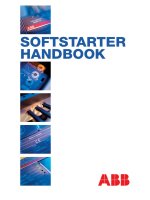The foundation engineering hand book - manjriker gunaratne – 902 trang
Bạn đang xem bản rút gọn của tài liệu. Xem và tải ngay bản đầy đủ của tài liệu tại đây (13.37 MB, 902 trang )
Page i
THE FOUNDATION ENGINEERING
HANDBOOK
Page ii
This page intentionally left blank.
Page iii
THE FOUNDATION ENGINEERING
HANDBOOK
Edited by
Manjriker Gunaratne
Taylor & Francis
Taylor & Francis Group
Boca Raton London New York
A CRC title, part of the Taylor & Francis imprint, a member of the
Taylor & Francis Group, the academic division of T&F Informa plc.
Page iv
Published in 2006 by
CRC Press
Taylor & Francis Group
6000 Broken Sound Parkway NW, Suite 300
Boca Raton, FL 33487–2742
© 2006 by Taylor & Francis Group, LLC
CRC Press is an imprint of Taylor & Francis Group
This edition published in the Taylor & Francis e-Library, 2006.
To purchase your own copy of this or any of Taylor & Francis or Routledge’s collection of thousands
of eBooks please go to www.eBookstore.tandf.co.uk.
No claim to original U.S. Government works
10 9 8 7 6 5 4 3 2 1
ISBN 0-203-48441-X Master e-book ISBN
ISBN 0-203-61133-0 (OEB Format)
International Standard Book Number-10: 0-8493-1159-4 (Print Edition) (Hardcover)
International Standard Book Number-13: 978-0-8493-1159-8 (Print Edition) (Hardcover)
Library of Congress Card Number 2005050886
This book contains information obtained from authentic and highly regarded sources. Reprinted
material is quoted with
permission, and sources are indicated. A wide variety of references are listed. Reasonable efforts have
been made to publish
reliable data and information, but the author and the publisher cannot assume responsibility for the
validity of all materials
or for the consequences of their use.
No part of this book may be reprinted, reproduced, transmitted, or utilized in any form by any
electronic, mechanical, or
other means, now known or hereafter invented, including photocopying, microfilming, and recording,
or in any information
storage or retrieval system, without written permission from the publishers.
For permission to photocopy or use material electronically from this work, please access
www.copyright.com
( or contact the Copyright Clearance Center, Inc. (CCC) 222 Rosewood
Drive, Danvers, MA
01923, 978–750–8400. CCC is a not-for-profit organization that provides licenses and registration for
a variety of users. For
organizations that have been granted a photocopy license by the CCC, a separate system of payment
has been arranged.
Trademark Notice: Product or corporate names may be trademarks or registered trademarks, and are
used only for
identification and explanation without intent to infringe.
Library of Congress Cataloging-in-Publication Data
The foundation engineering handbook/edited by Manjriker Gunaratne.
p. cm.
Includes bibliographical references and index.
ISBN 0-8493-1159-4
1. Foundations—Handbooks, manuals, etc. 2. Soil mechanics—Handbooks, manuals, etc. I.Gunaratne,
Manjriker.
TA775.F677 2006
624.1'5–dc22 20050508
Taylor & Francis Group
is the Academic Division of T&F Informa plc.
Visit the Taylor & Francis Web site at
and the CRC Press Web site at
Page v
Preface
A genuine need existed for an updated foundation engineering handbook that incorporates, in
addition to classical principles of foundation designs, significant contributions made to the art
of foundation design by practitioners and researchers during the last two decades. Of special
significance in this regard is the knowledge of (1) innovative in situ testing and site
improvement techniques that have evolved recently; (2) cost-effective design methods that
make use of geogrids for mechanically stabilized earth retaining structures; (3) concepts
involved in ground deformation modeling using finite elements; and (4) latest modifications
in the ACI codes applicable to structural design of foundations. This handbook largely fulfills
the above needs, since the editor and the contributors have focused on discussing the state of
the art of theoretical and applied foundation engineering and concrete design in a concise and
simple fashion.
Reliability-based design concepts that have been incorporated in most up-to-date structural
and pavement design guidelines are making inroads into foundation engineering as well.
Hence, the editor decided to include reliability-based design and LRFD (load resistance factor
design) concepts along with relevant illustrative examples in this handbook. This step not
only makes this handbook somewhat unique among other currently available foundation
engineering literature, but also it provides an opportunity for practitioners and students alike
to familiarize themselves with the basics of limit state design applied to foundation
engineering.
Furthermore, the editor’s extensive experience as an engineering educator has constantly
indicated that, in spite of the availability of a number of excellent textbooks in foundation
engineering, a quick reference that mostly focuses on significant and commonly-used
foundation engineering principles and illustrative examples has been in demand. This
handbook also addresses such a need, since it can be adopted conveniently as a textbook, both
at the undergraduate and graduate levels.
It is indeed my pleasure to have worked with a distinguished set of contributors who took
time off of their extremely busy professional careers and produced their best in keeping with
their usual professional performance. My appreciation is conveyed to Ingrid Hall of the Civil
and Environmental Engineering Department, University of South Florida’s civil engineering
graduate students Alex Mraz, Ivan Sokolic, Mathiyaparanam and Kalyani Jeyisankar, Dumina
Randeniya, and undergraduate student Mercedes Quintas for their help in preparing the
manuscript. The support of my children, Ruwan and Aruni, and my wife, Prabha, during the
arduous task of making this project a reality is also gratefully acknowledged. I wish to extend
my special thanks to Cindy Renee Carelli, former engineering acquisitions editor; Matt
Lamoreaux, current engineering acquisitions editor; Elizabeth Spangenberger; and other staff
of Taylor & Francis for their meticulous work on publishing this handbook. Thanks are also
due to the relevant publishers who permitted the use of material from other references.
I also express my profound gratitude to late Professor Alagiah Thurairajah, former dean of
the Faculty of Engineering, Peradeniya University, Sri Lanka, and prominent member of the
Cambridge University’s Cam Clay group for introducing me to North America and
postgraduate studies in geotechnics.
Page vi
Finally, it is to my mother, Jeannette Gunaratne, and my late father, Raymond Gunaratne,
that I dedicate this book.
Manjriker Gunaratne
University of South Florida
Tampa
Page vii
Abstract
This handbook contains some of the most recent developments in theoretical and applied
foundation engineering in addition to classical foundation design methods. The inclusion of
recent developments mostly enriches the classical design concepts in Chapters 3–7, 10 and 11.
It also enables the reader to update his or her knowledge of new modeling concepts applicable
to foundation design. Most recently developed in situ testing methods discussed in detail in
Chapter 2 certainly familiarize the reader with state-of-the-art techniques adopted in site
testing. In addition, modern ground stabilization techniques introduced in Chapter 12 by an
experienced senior engineer in Hayward-Baker Inc., a leading authority in site improvement
work across North America, provides the reader with the knowledge of effective site
improvement techniques that are essential for foundation design. Innovative and widely used
methods of testing pile foundations are introduced with numerical illustrations in Chapters 2
and 7. LRFD designs in Chapters 3 and 6 and the design of retaining structures with geogrids
included in Chapter 10 are unique features of this foundation engineering handbook. For the
benefit of the reader, the basic and advanced soil mechanics concepts needed in foundation
design are elaborated with several numerical examples in Chapter 1.
Page viii
This page intentionally left blank.
Page ix
Editor
Manjriker Gunaratne is a professor of civil engineering at the University of South Florida.
He completed his pre-engineering education at Ananda College, Colombo, Sri Lanka,
receiving the S.A.Wijetileke prize for the highest ranking student. Thereafter, he obtained
his bachelor of science in engineering (Honors) degree from the Faculty of Engineering,
University of Peradeniya, Sri Lanka, in 1978. In 1977, he was awarded the Professor
E.O.E.Pereira prize for the highest ranking student at the Part (II) examination in the
overall engineering class. Subsequently, he pursued postgraduate education in North
America, earning master of applied science and doctoral degrees in civil engineering from
the University of British Columbia, Vancouver, Canada, and Purdue University, West
Lafayette, Indiana, respectively. During his 18 years of service as an engineering educator,
he has authored 25 papers in a number of peer-reviewed journals, such as the American
Society of Civil Engineering (geotechnical, transportation, civil engineering materials, and
infrastructure systems) journals, International Journal of Numerical and Analytical
Methods in Geomechanics, Civil Engineering Systems, and others. In addition, he has made
a number of presentations at various national and international forums in geotechnical and
highway engineering.
He has held fellowships at the United States Air Force (Wright-Patterson Air Force Base) and
the National Aeronautics and Space Administration (Robert Goddard Space Flight Center)
and a consultant’s position with the United Nations Development Program in Sri Lanka. He
has also been a panelist for the National Science Foundation and a member of the task force
for investigation of dam failures in Florida, U.S.A.
Page x
This page intentionally left blank.
Page xi
Contributors
Dr. Austin Gray Mullins is an associate professor of civil engineering at the University of
South Florida, Tampa, Florida, who specializes in geotechnical and structural engineering.
He obtained B.S., M.S., and Ph.D. degrees in civil engineering from the University of
South Florida. Prior to joining USF’s department of civil and environmental engineering,
he worked as an engineer at Greiner Inc. Roadway Group, Tampa. His most recent research
work has been in the areas of statnamic testing of building foundations and drilled shafts as
well as structural testing of bridges. He is a professional engineer registered in the state of
Florida.
Dr. Alaa Ashmawy is an associate professor of civil engineering at the University of South
Florida, Tampa, Florida, with specialization in geotechnical and geoenvironmental
engineering. He obtained the B.S. degree in civil engineering from Cairo University, Egypt,
and M.S. and Ph.D. degrees from Purdue University. Prior to joining USF’s department of
civil and environmental engineering, he was a postdoctoral research associate at the
Georgia Institute of Technology. His most recent research work has been in the areas of
hydraulic and diffusion characteristics of surface amended clays, evaluation of the Purdue
TDR Method for soil water content and density measurement, and discrete element
modeling of angular particles. He is a professional engineer registered in the state of
Florida.
Dr. Panchy Arumugasaamy graduated with first class honors bachelor degree in civil
engineering from the University of Sri Lanka, Katubedde Campus, and is the recipient of
the 1973 gold medal from the UNESCO Team for ranking first in the Faculty of
Engineering and Architecture of that year. He earned his Ph.D. degree in structural
engineering in 1978 from the University of Sheffield, England. In 1998, he earned his
Executive M.B.A. graduate degree from Ohio University. He has over 25 years of extensive
experience in engineering consulting (civil and structural engineering), project management,
teaching, advanced research, and product development. He is well respected by his peers
for his competencies in the analysis and design of complex structural systems for buildings,
bridges, and other structures for different types of applications, and assessment of behavior
of elements using both classical and computer aided methods. He is familiar with many
codes of practices including American Codes (ACI, AISC, ASCE, SEAOC, and AASHTO),
CEP-FIP codes, BSI (for bridges), and CSA. He has hands-on experience in computer
modeling, computer aided design including 2D and 3D frame analysis, grillage analysis for
bridges, 2D and 3D finite element analysis, and plate analysis to optimize the structural
system (steel and concrete structures). He is also proficient in 3D computer modeling. He
has also specialized in optical engineering and holds many patents for his inventions. He
has published many papers on national and international journals as a coauthor and has
received the following awards for the best designs and research papers. He is currently
working with MS Consultants Inc. as the head of the structural division in Columbus, Ohio.
Page xii
He has been a research scholar and senior adjunct faculty at University of West Indies, St.
Augustine, Trinidad and Tobago (WI), Florida Atlantic University, Boca Raton, and research
associate professor at the University of Nebraska, Lincoln-Omaha.
James D.Hussin received his B.S. in civil engineering from Columbia University and M.S. in
geotechnical engineering from California Institute of Technology (CalTech). Dr. Hussin
has been with Hayward-Baker Inc. for 20 years and in his current position of director is
responsible for the company’s national business development and marketing efforts and
oversees engineering for the southeast U.S. and the Caribbean. Before joining Hayward-
Baker, Dr. Hussin was a geotechnical consultant in Florida and South Carolina. Dr. hussin
is a member and past chairman of the American Society of Civil Engineers (ASCE)
Geoinstitute National Soil Improvement Committee and is a current board member of the
National ASCE Technical Coordination Council that oversees the technical committees. Dr.
Hussin has over 20 publications, including associate editor of the ASCE Special
Publication No. 69, “Ground Improvement, Ground Reinforcement, Ground Treatment,
Developments 1987–1997.”
Page xiii
Contents
1. Review of Soil Mechanics Concepts and Analytical Techniques Used in
Foundation Engineering
Manjriker Gunaratne
1
2.
In Situ
Soil Testing
Gray Mullins
47
3. Spread Footings: Analysis and Design
Manjriker Gunaratne
87
4. Geotechnical Design of Combined Spread Footings
Manjriker Gunaratne
145
5. Structural Design of Foundations
Punchy Arumugasaamy
179
6. Design of Driven Piles and Pile Groups
Manjriker Gunaratne
235
7. Design of Drilled Shafts
Gray Mullins
299
8. Design of Laterally Loaded Piles
Manjriker Gunaratne
327
9. Construction Monitoring and Testing Methods of Driven Piles
Manjriker Gunaratne
363
10. Retaining Walls: Analysis and Design
Alaa Ashmawy
427
11. Stability Analysis and Design of Slopes
Manjriker Gunaratne
485
12. Methods of Soft Ground Improvement
James D.Hussin
529
13. Impact of Groundwater on the Design of Earthen Structures
Manjriker Gunaratne
567
Index 595
Page xiv
This page intentionally left blank.
Page 1
1
Review of Soil Mechanics Concepts and Analytical
Techniques Used in Foundation Engineering
Manjriker Gunaratne
CONTENTS
1.1 Introduction 2
1.2 Soil Classification 2
1.2.1 Mechanical Analysis 2
1.2.2 Atterberg Limits 4
1.2.3 Unified Soil Classification System 6
1.3 Effective Stress Concept 6
1.4 Strength of Soils 9
1.4.1 Drained and Undrained Strengths 9
1.4.2 Triaxial Tests 10
1.4.2.1 Triaxial Testing of Rocks 11
1.4.2.2 Selection of Triaxial Test Type Based on the Construction Situation 11
1.4.2.3 Computation of Strength Parameters Based on Triaxial Tests 13
1.4.3 Unconfined Compression Test 15
1.5 Compressibility and Settlement 16
1.5.1 Estimation of Immediate Settlement in Soils 17
1.5.1.1 Elastic Properties and In Situ Test Parameters 19
1.5.2 Estimation of Foundation Settlement in Saturated Clays 20
1.6 Soil Densities and Compaction 25
1.6.1 Bulk Unit Weight 25
1.6.2 Dry Unit Weight 26
1.6.3 Saturated Unit Weight 26
1.6.4 Submerged (Buoyant) Unit Weight 27
1.6.5 Soil Compaction 27
1.6.5.1 Laboratory Compaction 27
1.6.5.2 Evaluation of Field Compaction 29
1.7 Finite Element Concepts Used in Modeling of Earthen Structures 31
1.7.1 Finite Element Approach 31
1.7.2 Finite Element Formulation 31
1.7.3 Equilibrium and Compatibility Conditions 33
1.8 Common Methods of Modeling the Yielding Behavior of Soils 35
1.8.1 Modified Cam-Clay Model 36
1.8.1.1 Isotropic Consolidation of Clays 36
1.8.1.2 Critical State of Deformation of Clay 37
Page 2
1.8.1.3 Stress-Strain Relations for Yielding Clays
39
1.8.2 Cap Model
39
1.8.3 Nonlinear Elastic Stress-Strain Relations
42
1.8.3.1 Evaluation of Nonlinear Elastic Parameters
42
1.8.3.2 Evaluation of G
max
from Standard Penetration Tests
43
1.8.4 Concepts of Stress Dilatancy Theroy for Granular Soils
43
References
44
1.1 Introduction
Geotechnical engineering is a branch of civil engineering in which technology is applied in
the design and construction of structures involving geological materials. Earth’s surface
material consists of soil and rock. Of the several branches of geotechnical engineering, soil
and rock mechanics are the fundamental studies of the properties and mechanics of soil and
rock, respectively. Foundation engineering is the application of the principles of soil
mechanics, rock mechanics, and structural engineering to the design of structures associated
with earthen materials. On the other hand, rock engineering is the corresponding application
of the above-mentioned technologies in the design of structures associated with rock. It is
generally observed that most foundation types supported by intact bedrock present no
compressibility problems. Therefore, when designing common foundation types, the
foundation engineer’s primary concerns are the strength and compressibility of the subsurface
soil and, whenever applicable, the strength of bedrock.
1.2 Soil Classification
1.2.1 Mechanical Analysis
According to the texture or the “feel,” two different soil types can be identified. They are: (1)
coarse-grained soil (gravel and sand) and (2) fine-grained soil (silt and clay). While the
engineering properties (primarily strength and compressibility) of coarse-grained soils depend
on the size of individual soil particles, the properties of fine-grained soils are mostly governed
by the moisture content. Hence, it is important to identify the type of soil at a given
construction site since effective construction procedures depend on the soil type. Geotechnical
engineers use a universal format called the unified soil classification system (USCS) to
identify and label different types of soils. The system is based on the results of common
laboratory tests of mechanical analysis and Atterberg limits.
In classifying a given soil sample, mechanical analysis is conducted in two stages: (1) sieve
analysis for the coarse fraction (gravel and sand) and (2) hydrometer analysis for the fine
fraction (silt and clay). Of these, sieve analysis is conducted according to American Society
for Testing and Materials (ASTM) D421 and D422 procedures, using a set of U.S. standard
sieves (Figure 1.1) the most commonly used sieves are U.S. Standard numbers 20, 40, 60, 80,
100, 140, and 200, corresponding to sieve openings of 0.85, 0.425, 0.25, 0.18, 0.15, 0.106,
and 0.075mm, respectively. During the test, the percentage (by weight) of the soil sample
retained on each sieve is recorded, from which the percentage of soil (R%) passing through a
given sieve size (D) is determined.
On the other hand, if a substantial portion of the soil sample consists of fine-grained soils
(D<0.075mm), then sieve analysis has to be followed by hydrometer analysis
Page 3
FIGURE 1.1
Equipment used for sieve analysis. (Courtesy of the University of South Florida.)
(Figure 1.2). The hydrometer analysis test is performed by first treating the “fine fraction”
with a deflocculating agent such as sodium hexametaphosphate (Calgon) or sodium silicate
(water glass) for about half a day and then allowing the suspension to settle in a hydrometer
jar kept at a constant temperature. As the heavier particles settle, followed by the lighter ones,
a calibrated ASTM 152H hydrometer is used to estimate the fraction (percentage, R%) that is
still settling above the hydrometer bottom at any given stage. Further, the particle size (D) that
has settled past the hydrometer bottom at that stage in
FIGURE 1.2
Equipment used for hydrometer analysis. (Courtesy of the University of South Florida.)
Page 4
time can be estimated from Stokes’ law. Then, it can be seen that R% is the weight percentage
of soil finer than D.
Complete details of the above-mentioned tests such as the correction to be applied to the
hydrometer reading and determination of the effective length of the hydrometer are provided
in Bowles (1986) and Das (2002). For soil samples that have significant coarse and fine
fractions, the sieve and hydrometer analysis results (R% and D) can be logically combined to
generate grain (particle) size distribution curves such as those indicated in Figure 1.3. As an
example, from Figure 1.3, it can be seen that 30% of soil type A is finer than 0.075mm (U.S.
Standard no. 200 sieve), with R%=30 and D=0.075mm being the last pair of results obtained
from sieve analysis. In combining sieve analysis data with hydrometer analysis data, one has
to convert R% (based on the fine fraction only) and D (size) obtained from hydrometer
analysis to R% based on the weight of the entire sample in order to ensure continuity of the
curve. As an example, let the results from one hydrometer reading of soil sample A be R%=90
and D=0.05 mm. To plot the curve, one requires the percentage of the entire sample finer than
0.05 mm. Since what is finer than 0.05 mm is 90% of the fine fraction (30% of the entire
sample) used for hydrometer analysis, the converted R% for the final plot can be obtained by
multiplying 90% by the fine fraction of 30%. Hence, the converted data used to plot Figure
1.3 are R% =27 and D=0.05mm.
1.2.2 Atterberg Limits
As mentioned earlier, properties of fine-grained soils are governed by water. Hence, the effect
of water has to be considered when classifying fine-grained soils. This is achieved
FIGURE 1.3
Grain (particle) size distribution curves. (From Concrete Design Handbook, CRC Press. With
permission.)
Page 5
FIGURE 1.4
Variation of the fine-grained soil properties with the water content.
by employing the Atterberg limits or consistency limits. The physical state of a fine-grained
soil changes from brittle to liquid state with increasing water content, as shown in Figure 1.4.
Theoretically, the plastic limit (PL) of a soil is defined as the water content at which the
soil changes from “semisolid” to “plastic” (Figure 1.4). For a given soil sample, this is an
inherent property of the soil that can be determined by rolling a plastic soil sample into a
worm shape to gradually reduce its water content by exposing more and more of an area until
the soil becomes semisolid. This change can be detected by cracks appearing on the sample.
According to ASTM 4318, the PL is the water content at which cracks develop on a rolled
soil sample at a diameter of 3 mm. Thus, the procedure to determine the PL is one of trial and
error. Although the apparatus (ground glass plate and moisture cans) used for the test is
shown in Figure 1.5, the reader is referred to Bowles (1986) and Das (2002) for more details.
On the other hand, the liquid limit (LL), which is visualized as the water content at which
the state of a soil changes from “plastic” to “liquid” with increasing water content, is
determined in the laboratory using the Casagrande liquid limit device (Figure 1.5). This
device is specially designed with a standard brass cup on which a standard-sized soil paste is
applied during testing. In addition, the soil paste is grooved in the middle by a standard
grooving tool thereby creating a “gap” with standard dimensions. When the brass cup is made
to drop through a distance of 1 cm on a hard rubber base, the number of drops (blows)
required for the parted soil paste to come back into contact through a
FIGURE 1.5
Equipment for the plastic limit/liquid limit tests. (Courtesy of the University of South Florida.)
Page 6
distance of 0.5 in. is counted. Details of the test procedure can be found in Bowles (1986) and
Das (2002). ASTM 4318 specifies the LL as the water content at which the standard-sized gap
is closed in 25 drops of the cup. Therefore, one has to repeat the experiment for different trial
water contents, each time recording the number of blows required to fulfill the closing
condition of the soil gap. Finally, the water content corresponding to 25 blows (or the LL) can
be interpolated from the data obtained from all of the trials. The plasticity index (PI) is
defined as follows:
PI=LL−PL
(1.1)
1.2.3 Unified Soil Classification System
In the commonly adopted USCS shown in Table 1.1, the aforementioned soil properties are
effectively used to classify soils. Example 1.1 illustrates the classification of the two soil
samples shown in Figure 1.3. Definitions of the following two curve parameters are necessary
to accomplish the classification:
where D
i
is the diameter corresponding to the ith percent passing.
Example 1.1
Classify soils A and B shown in Figure 1.3.
Solution
Soil A. The percentage of coarse-grained soil is equal to 70%. Therefore, A is a coarse-
grained soil. The percentage of sand in the coarse fraction is equal to (70–30)/70×100 =57%.
Thus, according to the USCS (Table 1.1), soil A is sand. If one assumes a clean sand, then
Cc
=(0.075)
2
/(2×0.013)=0.21 does not meet criterion for SW (well-graded)
C
u
=(2)/(0.013)=153.85 meets criterion for SW
Hence, soil A is a poorly graded sand, or SP (poorly graded).
Soil B. The percentage of coarse-grained soil is equal to 32%. Hence, soil B is a fine-
grained soil. Assuming that LL and PL are equal to 45 and 35, respectively (then PI is equal
to 10 from Equation (1.1)), and using Casagrande’s plasticity chart (Table 1.1), it can be
concluded that soil B is a silty sand with clay (ML or lean clay).
1.3 Effective Stress Concept
Pores (or voids) within the soil skeleton contain fluids such as air, water, or other
contaminants. Hence, any load applied on a soil is partly carried by such pore fluids in
addition to being borne by the soil grains. Therefore, the total stress at any given location
Page 7
TABLE 1.1
Unified Soil Classification System
Division Description Group
Symbol
Identification Laboratory Classification Criteria
Clean
gravels
GW Well graded
gravels
C
u
>4, 1<C
c
<3
GP Poorly graded
gravels
Not meeting GW criteria
Gravel with
fines
GM Silty gravel Falls below A line in the plasticity chart, or PI
less than 4
More than
50% soil
US 200
sieve
(0.075 mm
More
than 50%
US No 4
(4.75mm)
GC Clayey gravel Falls above A line in the plasticity chart, or PI
greater than 7
Clean sand SW Well graded
sand
C
u
>4, 1<C
c
<3
SP Poorly graded
sand
Not meeting SW criteria
Sand with
fines
SM Silty sand Falls below A line in the plasticity chart, or PI
less than 4
More
than 50%
passing
US N 4
(4.75mm)
SC Clayey sand Falls above A line in the plasticity chart, or PI
greater than 7
ML Inorganic silts
with low
plasticity
More than
50% soil
passing
US 20
sieve
(0.075mm)
Fine grained soils
(LL<50)
CL Inorganic clays
with low
plasticity
OL Organic
clays/silts with
low plashcity
Fine grained soils
(LL>50)
MH Inorganic silts
with high
plasticity
CH Inorganic clays
with high
plasticity
OH Organic
clays/silts with
low plasticity
Use the Casagrande Plasticity chart shown
above
Highly organic soils Pt









